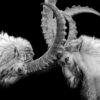Samhain and the soul of Ireland
As a child I always felt sorry around this time of year for those British kids I saw on a crackly, black and white HTV via our rabbit-ears TV aerial. They didn’t ‘do’ Halloween, having to make do with Guy Fawkes’ Night on November 5th. They might have had bonfires, but they didn’t have the dressing up, the going around the houses with a plastic bag that got fuller as the evening wore on, nor the excitement as we poured our treasures onto the kitchen table and sifted through the monkey nuts looking for anything containing sugar.
They didn’t have the Barmbrack with the hidden (cheap) ring and 5 pence piece. They didn’t have the Halloween games that my mother played with us every year: We had the late Autumn windfall harvest ones of course, involving bobbing apples in bowls of water or hanging from a string off the top of a door, but there were other darker ones too – saucers with either clay (for death), money (for wealth) or water (for travel) that, blindfolded, we chose between, thereby predicting our futures; or chestnuts placed in the front of the fire grate, one for each of us – the first to crack and break being the one of us to suffer an early death.
This was always the other side of or Halloween. While elsewhere it may have become a marketing executives’ dream of a schmaltzy public holiday, all gaudy merchandising and Trick or Treat (a phrase that didn’t exist in Ireland when I was a boy – we just knocked on the door and stood holding our bags wide open with a gormless look on our ghost- or vampire-painted faces) – in Ireland there has always been the sense of this being a time when two worlds come close.
I always had a sense of almost sub-conscious fear as we walked from house to house, past dark wooded areas, old stone walls, or graveyards. Our dress-up always emphasised death or the super-natural, no Buzz Lightyears or Elsa from Frozen. Hawthorn trees were respected and sometimes adorned, especially in rural parts. We didn’t have any tradition of pumpkins back then, although that tradition does go back to Celtic times of carving frightening faces in turnips to ward off evil spirits, so I’m happy to add it to my Halloween rituals now.
In our Celtic past, Samhain was the most important by far of the four quarter days of the year. It marked the end of autumn and the beginning of the dark period of winter. It was a time when the boundaries between light and dark are at their weakest, when the physical and supernatural worlds were closest and magical things could happen. It was a time of crossing over, between the world of the living and the worlds of the Aos Sidhe and the dead. It was a time when we were aware that there was more to our existence than we could see. More than our being master of all. Acknowledgement that we are a small part in a mysterious existence that we can never fully understand.
My own children are almost all past the stage of going out collecting door-to-door on Halloween now, (although at least one of them will try to squeeze another year or two out of that tradition, if COVID ever allows us out of the house again). But while that part of Halloween might not be a part of our annual ritual from now on, I hope that we never lose the sense of dark mystery and respect for what is outside of our understanding, that Samhain has always meant in this country.
Join us strengthening our leadership muscles on an online LIFT leadership session. Now more than ever we need to increase our positive attitude, resilience and innovative skills. These 45 minute sessions are open to everyone in Ireland.




